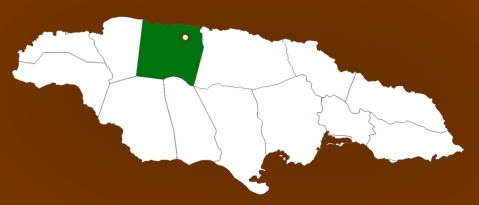Hampshire Great House

While I was in the hunt for Swanswick Great house, I noticed a great house out in the middle of a cane field so I cruised down the next available clay road through the field and pulled up to the great house. An extended family of an employee of Everglades Sugar Company presently lives in the house. The family sat around a large cast iron pot in which the mother washed her small daughter. I tried to communicate with the family about my desire to take pictures of the great house but I was unsuccessful because of my limited knowledge of Jamaica patois. Soon a man who came out of the adjacent kitchen building saved me. He was fluent in the King’s English and I explained my desire to photograph the house. He said, “Go ahead,” and allowed me to go about my business, all the while following me around.
The exterior appeared to be in good shape. The ground floor was constructed of cut, squared stone and the top was probably a timber and rubble type of construction that was covered with stucco. The hip roof is presently corrugated galvanized metal but was probably originally cedar shingles since cedar is prevalent in the surrounding hills. Leading up to the second floor was a magnificent cut stone stairway built over a substantial arch. Three arched doors at the front of the building, on the ground floor, created a feel of opulence. There were many doors and no windows in the lower level, which probably were used for access to storage. By living on the second floor, the overseer could take advantage of any welcoming breezes.
Approximately one hundred feet from the house was the kitchen and storage building. It also was made of cut stone. As I walked up, a friendly goat and her kid ambled out of the kitchen to greet me. The family still uses the kitchen; in fact, dinner was cooking over a charcoal fire. I’m not sure if the family invites the goats for meals. In colonial times, the kitchen was always separate from the house because of the risk of fire and to keep the heat out of the house.
Richard Brissett who originally owned Hampshire Estate also owned the Berkshire Estate. These estates are adjacent and Hampshire is about halfway down the main road (still known as Hampshire Lane) from the Clarks Town to Jackson Town. In 1840, the Jamaica Almanac reported that it consisted of 1560 acres and belonged to the Sir Simon H. Clarke, who also owned Mahogany Hall Estate and Long Pond Estate. The adjacent Clark Town is named after him because he donated the land to ex-slaves following emancipation in 1832.











Great project for you while there.
Sent from my iPad
>
LikeLike
Barbara,
Thanks for your comment. I’m lovin’ it.
Michael
LikeLike